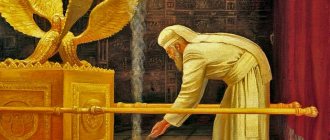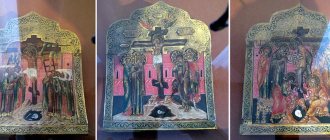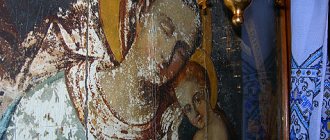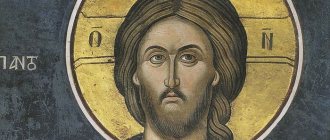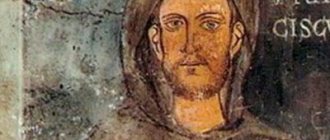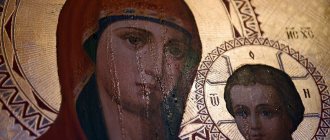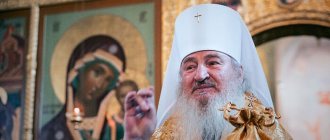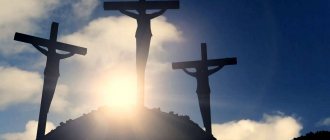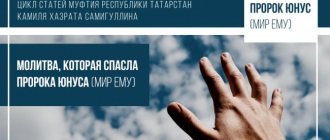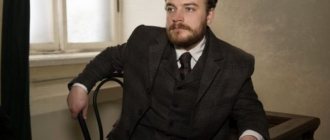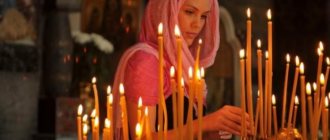Not everyone knows that everyone who participated in the crucifixion of Jesus Christ died a terrible death. The high priest Caiaphas did not escape his fate. At the same time, he predicted his death.
The fact is that when Christ did not deny that he was the Son of God before Caiaphas, he flew into a rage and tore his priestly robes. By this act he deprived himself of the right to the priesthood and condemned himself to death.
The Law of Moses said that the high priest should not tear his clothes under threat of death (Lev. 10:6) Caiaphas soon died in great torment, and on the site of his house the Church of St. Peter in Gallicantu was erected - it was here that Peter denied Jesus .
The high priest Caiaphas is mentioned several times in the Gospel
Caiaphas and Anna
Caiaphas (Yoseph Bar-Cayaphas, Hebrew יוֹסֵף בַּר קַיָּפָא, Greek Καϊάφα (the name, probably from Aramaic, means “humility”, according to other sources, “researcher”) - high priest of Judah and from 18 to 37 Josephus mentions him, calling him Joseph, nicknamed Caiaphas (Jewish Antiquities, Book XVIII, 2.2).
There are also sources in which he is also called Caiaphas from Greece. Caiaphas is mentioned many times in the three Gospels (Matt. 26:3, Matt. 26:57, Luke 3:2, John 11:49-52, John 18:13-28), as well as in the Acts of the Apostles (Acts. 4:6).
This occurs first in the story of John the Baptist (Luke 3:1-2). He later appears in the story of the Passion of the Lord; in the house of Caiaphas the fate of Jesus Christ is finally decided: (John 11:46-53).
The procurator of Judea Pontius Pilate and the high priest Caiaphas in a modern image. Pontius Pilate appointed Caiaphas to the position of high priest. Photo: xn--80aebqdeap5ate.xn--p1ai
It is known that the procurators ruled the province of Judea with the help of the high priests they appointed. Caiaphas was the high priest of the Temple for 18 years. He was appointed to this post by Valery Grat, predecessor of Pontius Pilate.
The consul Aulus Vitellius, the future emperor of Rome, removed him from power. Caiaphas was a Sadducee, son-in-law of the high priest Annas (Hannan), and an obedient instrument in the hands of his father-in-law.
Cephas was high priest for eighteen years.
Even after leaving his post, Anna continued to tenaciously hold power in his hands and, in fact, had sole control over temple posts and the treasury.
According to some historians, it was Annas, through his son-in-law, who made the decision to execute Jesus as one of those rebellious preachers with whom Judea was flooded at that time.
These preachers blasphemed the authority of the Roman emperor and predicted the imminent arrival of the Messiah and the renewal of the world.
Many legends were and are told about the life and death of the high priest Caiaphas. For example, it is believed that he himself predicted his death when he tore his priestly robes at the trial of Jesus Christ.
Legends also say that he died in agony, and this was his punishment for an unjust trial.
~ Joseph Kaifa ~
Osif Kaifa- character in the novel “The Master and Margarita”, Jewish high priest, president of the Sanhedrin.
The image of I.K. goes back to the chairman of the trial of Jesus Christ mentioned in the Gospels, whose name in Russian is transcribed either as Joseph Caiaphas, or as Joseph Caiaphas. The first option was adopted in the Synodal translation and is found in early editions of Bulgakov’s novel.
The threat of Pontius Pilate I.K. has its source in the work of the French historian Ernest Renan (1823-1892) “Antichrist” (1866), which tells about the capture and destruction of Jerusalem by the troops of the future Roman emperor Titus (39-81) in 70. In the archive Bulgakov has preserved an extract from this book listing the legions that participated in the siege and storming of the city. Renan wrote that "with Titus were four legions: the 5th Macedonica, the 10th Fretensis, the 12th Fulminata, the 15th Apollinaris, not counting the numerous auxiliaries brought by his Syrian allies, and many Arabs who came for the sake of plunder." .
The procurator predicts to the high priest: “You will see more than one cohort in Yershalaim, no! The entire Fulminata legion will come under the walls of the city, the Arab cavalry will approach, then you will hear bitter weeping and lamentations!” This probably reflected the impressive picture of the last days of Jerusalem drawn by the French historian: “...A hot battle took place in all the courtyards and on all the porches. A terrible massacre took place around the altar, a building in the form of a truncated pyramid, topped with a platform and rising in front of the temple; the corpses of those killed on the platform rolled down the steps and formed heaps at the foot of the building. Streams of blood flowed from all sides; nothing was heard except the piercing screams of those being killed, who, dying, conjured the heavens. There was still time to take refuge in the upper city; but many preferred to be killed, considering it an enviable fate to die for their sanctuary; others threw themselves into the flames, or threw themselves at the swords of the Romans, or stabbed themselves, or killed each other. The priests who managed to climb onto the roof of the temple pulled out the points that were there, along with the lead sheathing, and threw them down on the Romans, they continued this until the flames consumed them. A large number of Jews gathered around the "holy of holies", according to the word of the prophet, who assured them that the moment had come when God would show them signs of salvation. One of the galleries, in which up to six thousand of these unfortunates (almost exclusively women and children) took refuge, was burned along with them. At that moment, only two gates and a part of the fence intended for women survived from the entire temple. The Romans erected their eagles on the spot where the sanctuary was located and worshiped them according to the customs of their cult.”
Perhaps this description is associated with the words of I.K. that the Jewish people will be protected by God and protected by Caesar, words that in the eyes of the readers of the novel are refuted not only by the prophecy of Pilate, but also by the sad fate of Jerusalem several decades later, which was described in Renan's "Antichrist". Streams of blood are associated with Pilate’s promise to give Yershalaim not water, but, by implication, blood.
The ominous words of Pontius Pilate I.K.: “So know that you, High Priest, will have no peace from now on! Neither you nor your people,” and Pilate pointed into the distance to the right, to where the temple was burning in the heights, “I’m telling you this - Pilate of Pontus, horseman of the Golden Spear!” have their source not only in the scene of the destruction of the temple from Renan’s book, but also in the story of the French writer Nobel laureate Anatole France (Thibault) (1844-1924) “Procurator of Judea” (1891).
There Pilate speaks about the future fate of the Jews, who eventually achieved his removal from office: “Unable to control them, we will have to destroy them. Eternally disobedient, plotting indignation in their ardent thoughts, they will rise up against us with a fury, next to which the anger of the Numidians and the threats of the Nartas will seem to us like the whims of a child... It is impossible to pacify this people. It must be destroyed. Jerusalem must be wiped off the face of the earth. No matter how old I am, perhaps the day will come when I will see how its walls will fall, how flames will devour its houses, how the inhabitants will be struck by the sword and the place where the temple stands will be leveled. And on this day I will finally be avenged."
Pilate France blames the Jews only for his resignation. Bulgakov places the blame not on the Jewish people as a whole, but on its leader, I.K., and this blame is the execution of Yeshua Ha-Nozri, which was achieved by the high priest. The procurator directly says to I.K.: “You will remember the saved Bar-Rabban and you will regret that you sent the philosopher to death with his peaceful preaching!”
However, the writer makes his Pilate threaten with future punishments not only the head of the Sanhedrin, but also the entire Jewish people, as if turning inside out the vile wisdom attributed to the high priest in the Gospels, according to which it is better to let one person perish than an entire people. This thesis is defended by I.K., asserting: “It is not peace that the seducer of the people brought us to Yershalaim, and you, horseman, understand this very well. You wanted to release him so that he would confuse the people, outrage the faith and bring the people under the Roman swords! But I, the High Priest of the Jews, while I am alive, will not allow my faith to be mocked and will protect the people!”
Here I.K. in a hidden form quotes the words of Jesus Christ from the Gospel of Matthew: “I did not bring you peace, but a sword,” interpreting them not allegorically, as in the Gospel text, where Christ thus only asserts the primacy of his teaching over family ones, social or other bonds, but literally, as a desire to bring the Jews under the swords of the Romans.
In the preparatory materials for “The Master and Margarita,” an extract from Heinrich Graetz’s “History of the Jews” was preserved, stating that Jesus “was brought to the Sanhedrin, but not the Great, but to the Small Sanhedrin, which consisted of 23 members, where the High Priest Joseph Caiaphas presided.” Therefore, I.K. acts as the president of the Small Sanhedrin, which pronounced the death sentence on Yeshua.
Top
The High Priest is the head and commander of the priests in the Jewish Church
High Priest
The high priest in the Jewish church was considered the senior and first priest (2 Chron. 19:11). He was the head and commander of the priests in this church. The first high priest was Aaron.
Then they became his successors from the oldest families of his descendants. Ordination to the rank of high priest was performed according to a special rite and was distinguished by an abundant outpouring of peace on the head of the initiate.
The clothes of the high priest were more majestic and valuable than the clothes of ordinary priests. A description of this ceremony and the high priestly vestments is found in Exodus 28 and Exodus 29 and Lev 8.
Priesthood of the Jewish Church. In the Jewish church, the high priest was its head and he ruled over the other priests. Photo: pravoslavie.ru
The clothing of the high priest on the day of propitiation was simpler than on ordinary days, and consisted only of a smooth linen ephod with a belt around it, which is why the Jews called it white clothing, while the first was called gold.
High priests were usually appointed to this position for life. In the last years of the kingdom of Judah, this high position was occupied by many high priests at the same time, many of them being of bad morals and vicious, such as the high priest Caiaphas.
The High Priest of the Jewish Church was its head.
A particularly solemn and exclusive duty of the high priests was to enter the Holy of Holies and offer sacrifices therein for the sins of the people on the day of propitiation.
In Lev 16 we find a description of this most solemn sacred service. The High Priest was the head of all other priests and alone could enter the Holy of Holies. He stood before the Face of God closest to Him and prayed for all the Israelites.
He was, so to speak, a mediator between earth and heaven and a prototype of the Lord Jesus Christ, the great High Priest who passed through the heavens.
Ossuary of Caiaphas. This ossuary is believed to contain the remains of the high priest's son, Joseph Ciathas, and his son. Photo: hrampokrov.ru
There is historical evidence of the existence of the high priest Caiaphas. So in November 1990, during the construction of a water park in Jerusalem, in an area called the “Forest of Peace,” a burial chamber was discovered.
It was sealed around the time of the second Jewish War (70). The chamber was divided by partitions into four parts, where there were 6 intact and 6 split (probably by robbers) ossuaries.
1990
This year a burial chamber from around 70 was discovered in Jerusalem.
It is possible that this ossuary contained the remains of the son of the Gospel Caiaphas, who bore the same name as his father. This is evidenced by the inscription preserved on the ossuary.
In the ossuary, archaeologists found the bones of six people: two infants, one child aged 2 to 5 years, a teenager about 13 years old, an adult woman and a man about 60 years old. Probably the last skeleton belongs to the high priest.
Ossuary of Joseph, son of Caiaphas[ | ]
Ossuary of Joseph, son of Caiaphas
In November 1990, during the construction of a water park in Jerusalem - in an area called the "Forest of Peace", excavators unexpectedly broke through the roof of an artificial cave, which turned out to be a burial chamber, sealed around the time of the second Jewish War (70 ). The chamber was divided by partitions into four parts, where there were 6 intact and 6 split (probably by robbers) ossuaries. On the narrow side of one of them they read the inscription “'husf br kfa”
, that is, in modern language
“Yehosef bar Qafa”
- “
Joseph, son of Caiaphas
.” It is possible that this ossuary contained the remains of the son of the Gospel Caiaphas, who bore the same name as his father[4].
In the ossuary, archaeologists found the bones of six people: two infants, one child aged 2 to 5 years, a teenager about 13 years old, an adult woman and a man about 60 years old. Probably the last skeleton belongs to the high priest. After the completion of the research, the remains were transferred to the Israeli Ministry of Religious Affairs and buried on the Mount of Olives[5]. It is interesting that a coin was placed in the deceased’s mouth, which is typical for Greek, not Jewish custom[4].
The High Priest Caiaphas condemned Christ to death in advance
The history of the Passion of the Lord indicates that the high priest Caiaphas condemned Jesus Christ to death in advance. This is what the Gospel says:
“And some of them went to the Pharisees and told them what Jesus had done. Then the chief priests and Pharisees held a council and said, “What should we do?”
This Man does many miracles. If we leave Him like this, then everyone will believe in Him, and the Romans will come and take possession of both our place and our people.
One of them, a certain Caiaphas, being the high priest that year, said to them: you know nothing, and you will not think that it is better for us that one person should die for the people, than that the whole people should perish.
He did not say this on his own, but, being high priest that year, he predicted that Jesus would die for the people, and not only for the people, but in order to gather together the scattered children of God. From that day on they decided to kill Him.”
(John 11:46-53)
Meeting of the Great Sanhedrin. American Encyclopedia 1883 The High Priest Caiaphas at one of the meetings of the Sanhedrin suggested that the Sadducees execute him. Photo: pravoslavie.ru
Researchers point to the fact that Caiaphas was the high priest in Judea for this particular year. The fact is that the Law of Moses requires the installation of a high priest for life. The Romans began to violate it by appointing a high priest annually.
Thus, in the year of Christ’s execution, Pontius Pilate confirmed Joseph Caiaphas in this position. There is also a version that at this time there were two high priests in Judea: Annas and Caiaphas, who performed their duties in turns.
As for the words “one man must die” and “die for the people,” historians believe that they indicate that Jewish society at that time had strong communal traditions.
There is a version that at the time of Christ there were 2 high priests in Judea: Annas and Caiaphas.
As for the execution of Jesus Christ itself, after its meeting the Sanhedrin began to look for false witnesses against Him in order to put Him to death, but could not find them. Finally, two false witnesses were found. They began to talk about what Jesus said: I can destroy the temple of God and build it in three days.
This is how slanderers distorted the words of the Lord when He said some time ago on Easter: “...destroy this temple, and in three days I will raise it up...”. At the same time, the Savior spoke in a similar way about His death and three-day resurrection.
Video: The trial of Jesus Christ by the Jewish high priests. At 35 seconds the author talks about the trial of the Jewish high priests over Christ
After this, standing up, the high priest Caiaphas said to Christ: “I adjure you by the living God, tell us, are you the Christ, the Son of God?” Jesus answered him: “Yes, I am. And you will see the Son of Man sitting at the right hand of power and coming on the clouds of heaven.”
Then the high priest, as a sign of deep sorrow and indignation, tore his clothes and said: “He is blaspheming! What more need do we need witnesses? Behold, now you have heard His blasphemy, as it seems to you.”
And the members of the Sanhedrin said in response: “He is guilty of death.” Jewish court order forbade the death penalty to be passed at night. To formally comply with this requirement, early in the morning the Sanhedrin met again and decided to betray the Lord Jesus Christ to death.
Joseph Kaifa
- character in the novel “The Master and Margarita”, Jewish high priest, president of the Sanhedrin. The image of I.K. goes back to the chairman of the trial of Jesus Christ mentioned in the Gospels, whose name in Russian is transcribed either as Joseph Caiaphas, or as Joseph Caiaphas. The first option was adopted in the Synodal translation and is found in early editions of Bulgakov’s novel.
The threat of Pontius Pilate I.K. has its source in the work of the French historian Ernest Renan (1823-1892) “Antichrist” (1866), which tells about the capture and destruction of Jerusalem by the troops of the future Roman emperor Titus (39-81) in 70. In the archive Bulgakov has preserved an extract from this book listing the legions that participated in the siege and storming of the city. Renan wrote that "with Titus were four legions: the 5th Macedonica, the 10th Fretensis, the 12th Fulminata, the 15th Apollinaris, not counting the numerous auxiliaries brought by his Syrian allies, and many Arabs who came for the sake of plunder." .
The procurator predicts to the high priest: “You will see more than one cohort in Yershalaim, no! The entire Fulminata legion will come under the walls of the city, the Arab cavalry will approach, then you will hear bitter weeping and lamentations!” This probably reflected the impressive picture of the last days of Jerusalem drawn by the French historian: “...A hot battle took place in all the courtyards and on all the porches. A terrible massacre took place around the altar, a building in the form of a truncated pyramid, topped with a platform and rising in front of the temple; the corpses of those killed on the platform rolled down the steps and formed heaps at the foot of the building. Streams of blood flowed from all sides; nothing was heard except the piercing screams of those being killed, who, dying, conjured the heavens. There was still time to take refuge in the upper city; but many preferred to be killed, considering it an enviable fate to die for their sanctuary; others threw themselves into the flames, or threw themselves at the swords of the Romans, or stabbed themselves, or killed each other. The priests who managed to climb onto the roof of the temple pulled out the points that were there, along with the lead sheathing, and threw them down on the Romans, they continued this until the flames consumed them. A large number of Jews gathered around the "holy of holies", according to the word of the prophet, who assured them that the moment had come when God would show them signs of salvation. One of the galleries, in which up to six thousand of these unfortunates (almost exclusively women and children) took refuge, was burned along with them. At that moment, only two gates and a part of the fence intended for women survived from the entire temple. The Romans erected their eagles on the spot where the sanctuary was located and worshiped them according to the customs of their cult.”
Perhaps this description is associated with the words of I.K. that the Jewish people will be protected by God and protected by Caesar, words that in the eyes of the readers of the novel are refuted not only by the prophecy of Pilate, but also by the sad fate of Jerusalem several decades later, which was described in Renan's "Antichrist". Streams of blood are associated with Pilate’s promise to give Yershalaim not water, but, by implication, blood.
The ominous words of Pontius Pilate I.K.: “So know that you, High Priest, will have no peace from now on! Neither you nor your people,” and Pilate pointed into the distance to the right, to where the temple was burning in the heights, “I’m telling you this - Pilate of Pontus, horseman of the Golden Spear!” have their source not only in the scene of the destruction of the temple from Renan’s book, but also in the story of the French writer Nobel laureate Anatole France (Thibault) (1844-1924) “Procurator of Judea” (1891).
There Pilate speaks about the future fate of the Jews, who eventually achieved his removal from office: “Unable to control them, we will have to destroy them. Eternally disobedient, plotting indignation in their ardent thoughts, they will rise up against us with a fury, next to which the anger of the Numidians and the threats of the Nartas will seem to us like the whims of a child... It is impossible to pacify this people. It must be destroyed. Jerusalem must be wiped off the face of the earth. No matter how old I am, perhaps the day will come when I will see how its walls will fall, how flames will devour its houses, how the inhabitants will be struck by the sword and the place where the temple stands will be leveled. And on this day I will finally be avenged."
Pilate France blames the Jews only for his resignation. Bulgakov places the blame not on the Jewish people as a whole, but on its leader, I.K., and this blame is the execution of Yeshua Ha-Nozri, which was achieved by the high priest. The procurator directly says to I.K.: “You will remember the saved Bar-Rabban and you will regret that you sent the philosopher to death with his peaceful preaching!”
However, the writer makes his Pilate threaten with future punishments not only the head of the Sanhedrin, but also the entire Jewish people, as if turning inside out the vile wisdom attributed to the high priest in the Gospels, according to which it is better to let one person perish than an entire people. This thesis is defended by I.K., asserting: “It is not peace that the seducer of the people brought us to Yershalaim, and you, horseman, understand this very well. You wanted to release him so that he would confuse the people, outrage the faith and bring the people under the Roman swords! But I, the High Priest of the Jews, while I am alive, will not allow my faith to be mocked and will protect the people!”
Here I.K. in a hidden form quotes the words of Jesus Christ from the Gospel of Matthew: “I did not bring you peace, but a sword,” interpreting them not allegorically, as in the Gospel text, where Christ thus only asserts the primacy of his teaching over family ones, social or other bonds, but literally, as a desire to bring the Jews under the swords of the Romans.
In the preparatory materials for “The Master and Margarita,” an extract from Heinrich Graetz’s “History of the Jews” was preserved, stating that Jesus “was brought to the Sanhedrin, but not the Great, but to the Small Sanhedrin, which consisted of 23 members, where the High Priest Joseph Caiaphas presided.” Therefore, I.K. acts as the president of the Small Sanhedrin, which pronounced the death sentence on Yeshua.
Almost nothing is known about how Caiaphas died.
Almost nothing is known about the fate of the High Priest of Judea Joseph Caiaphas after he actually approved the death sentence of Jesus Christ. At the same time, it is clear that the Savior did not call for the destruction of the temple, so this sentence cannot be considered fair.
In this regard, the legend of his terrible death began to spread among the people, although we do not know how Caiaphas died.
The fact is that he is not mentioned anywhere else in the Gospel and historical sources. It is only known that after the execution of Christ, he gave up the post of high priest to one of the sons of Anna, of whom, as is known, there were five.
The Trial of Caiaphas, Orthodox icon. Having torn his priestly robes, Caiaphas lost his high priesthood. Photo: pravoslavie.ru
It is quite possible that Caiaphas’s resignation was connected with his unexpected act. The fact is that during the trial of Christ, he committed the most unexpected but significant act - he tore the priestly robes in a rage.
Trying to put pressure on the judges and achieve the condemnation of Christ, the high priest himself condemned himself, since he lost his right to the priesthood. After all, according to the law of Moses (Lev. 10:6), the high priest was not supposed to tear his clothes under threat of death.
Having torn his priestly robes, Caiaphas ceased to be a high priest.
Among the Jews there was a custom of tearing clothes during the death of loved ones, but even this custom did not apply to priests.
The priest's clothes had to be made from a single piece of cloth and shine with cleanliness, since they were intended for service in the temple and symbolized the Great Reality. When priestly vestments were not used in worship, they were kept in the temple.
Orthodox Life
THOMAS
We are free to change our minds—as long as we live—and God humbly waits to see what we decide. But one day the time comes to make the final choice. For many people who surrounded Christ during the days of His earthly life, this time came on the eve of His suffering. Everyone had to decide whether he was with Christ or with the opponents of Christ.
According to the Law of Moses, the people of Israel could have only one high priest. He stood at the head of all other ministers of the Jerusalem Temple and resolved key issues related to the religious life of the people. It was a very important and lifelong ministry.
In the Gospel we repeatedly find references to high priests. But during the earthly life of Jesus Christ, the Jewish people - the heir of ancient Israel - were already concerned about observing not so much the law as external rituals.
De facto, there were two of them in Jerusalem at that time - Anna (short for Anan, Hebrew for “mercy”) and his son-in-law Joseph Caiaphas. Although, strictly speaking, Anna served as high priest for only nine years - from 6 to 15 AD, and then he was removed from office by the new prefect (Roman governor) of Judea Valerius Gratus, the predecessor of Pontius Pilate. But even after retiring, Anna retained enormous influence - perhaps not least because he controlled the temple trade in sacrificial animals, was very rich and often lent money to the Romans living in Jerusalem.
Caiaphas served as high priest longer - from 18 to 36 AD, but it seems that he obeyed his powerful father-in-law in everything. Therefore, Christ, taken in the Garden of Gethsemane, was first brought to Anna. And he himself sent Him to Caiaphas in order to maintain the appearance of order and legality.
Both Annas and Caiaphas belonged to the religious party of the Sadducees: they, of course, believed in God, but not in the afterlife of the soul. And the very existence of the soul, it seems, was doubted. It was the Sadducees who ironically asked Christ whose wife would be after death a woman who had replaced seven husbands and remained childless.
The high priests wanted to settle scores with Jesus for a long time; it was not for nothing that they constantly sent provocateurs to Him, trying to catch Him doing something illegal.
First of all, they didn't like what He was saying. After all, Christ not only filled traditional rituals and laws with their original meaning, He openly denounced the leaders of the Jewish people, who sat on the seat of Moses, placing heavy and unbearable burdens on people’s shoulders, but they themselves do not want to move them with a finger (Matthew 23:2, 4 )!
Secondly, they did not like the way He spoke—as one in authority, and not as the scribes and Pharisees” (Matthew 7:29).
But most of all they did not like the impression that Jesus made on the people. There were different opinions about Him among people: some revered Him as a great teacher of wisdom, others as a prophet (or even one of the great prophets who rose from the dead), and still others as the long-awaited Messiah, Christ, the Anointed of God. But one thing was obvious to everyone: Never did a man speak like this Man (John 7:46).
So the high priests were tormented by banal passions - envy and malice.
But in the eyes of the people they did not want to look envious and vindictive, so they were afraid to publicly denounce such an authoritative Teacher as Christ, not to mention arresting Him. They needed a reason - but there was no reason...
However, after Jesus raised Lazarus, who had already been lying in the tomb for four days, the chief priests could wait no longer. This miracle was too obvious, too tempting, and also happened too close to the capital and with too many witnesses (Bethany, where it happened, is only three kilometers from Jerusalem)! Jesus must be removed urgently, the high priests and the Pharisees who joined them decided at an urgently convened council: If we leave Him like this, then everyone will believe in Him (John 11:48).
And then, as if on purpose, in a few days Easter, Jerusalem will be full of people, a crowd will gather around Jesus as usual, and you will no longer approach Him. This means that we need to hurry up and “resolve the issue” before Easter, as quietly and unnoticeably as possible, the high priests decided.
And then Caiaphas uttered an amazing phrase: it is necessary for Jesus to die for the people (John 11:50–51). Caiaphas was, of course, an unfit man, but still he was a high priest and, without realizing it, he uttered a prophecy. Christ truly died for all people, voluntarily taking responsibility for the sins of everyone.
However, the plans of Annas and Caiaphas were only partially realized. It did not work out to execute Christ “quietly”—a huge crowd gathered for Pilate’s trial, which the high priests had to deliberately incite against Jesus. And the execution on Golgotha also attracted spectators. But it was possible to manage before the onset of Easter, which that year fell on Saturday, but it was no longer important. The day after the Jewish Passover, Christ rose again - and the holiday acquired a new meaning and new content.
Having decided to execute Jesus, the high priests acted according to the plan and sought to quickly bring the matter to a conclusion. Therefore, during the trial, Jesus did not answer their questions: they, like the entire trial, were a pure formality, a re-enactment.
And yet it cannot be said that Annas and Caiaphas did not have the opportunity to turn back. The trial of the Savior could have been carried out according to the law: normally, in the daytime, convene all members of the Sanhedrin (supreme court), first listen to witnesses (real, and not hastily prepared), and not rush to pronounce a verdict. One could at least think about it when, in response to the direct question: “Are you the Christ, the Son of God?” the accused gave an essentially affirmative answer. And Pilate, who was ready to release an innocent man, could not have been blackmailed by saying: “If you release him, you are not a friend of Caesar.”
But the high priests did not take advantage of any of these opportunities. This happens when a person firmly decides not to listen to the voice of conscience and, closing his eyes, rushes towards his own death.
...In 1990, archaeologists found in Jerusalem the burial place of a certain Caiaphas and members of his family. A coin was found in one of the skulls. It was a pagan custom to place such a coin in the mouth of the deceased: it was believed that the deceased would pay the ferryman Charon with it for crossing the river separating the world of the living from the world of the dead. If this is the same Caiaphas (and ordinary people, of course, did not have named tombs), then his death turned out to be quite worthy of his life.
Igor Tsukanov
Images of Caiaphas are often found on icons
Images of the high priest Caiaphas are often found in the cycles of the Passion of Christ.
For the first time, individual scenes and cycles of the Passion with the participation of this character appear in Christian art in the 4th century. on the reliefs of sarcophagi, which, due to the theme of the images, were called “Passionate”, as well as on carved ivory plates decorating the reliquaries.
One of the earliest examples of the image of Caiaphas is the scene “Christ before the Sanhedrin” on the lid of the reliquary (lipsanoteca) from the museum in Brescia (IV century).
Christ before Caiaphas (Matthias Stom, 1630s). The plot of Caiaphas' trial over Jesus Christ is popular in secular painting. Photo: upload.wikimedia.org
This scene is part of a cycle of 6 compositions, which are arranged in 2 registers, and is placed in the lower register next to the scene “Bringing to Pilate. Pilate washes his hands."
On the left side of this composition there are 2 high priests sitting on a throne, one of them points his finger at Jesus Christ, who is held by two servants.
Although the vestments of the Jewish high priests are described in detail in the Bible (Exodus 28), they are not followed literally in Christian art. The high priests on the lid of the reliquary are depicted beardless, with short curly hair, dressed in long clothes (tunics and himation).
Images of Caiaphas on icons have appeared since the 4th century.
In ancient Russian art of the late 15th century. Passionate subjects begin to appear on icons. On the Novgorod tablet (late 15th century), in the scene “Bringing to Anna and Caiaphas,” the latter is sitting at the table next to Anna.
He is depicted without a headdress and in a robe torn to the waist. Caiaphas in these scenes appears in robes imitating the historical clothes of the Jewish high priests - in a high turban hat, long lower robe and short upper robe (ephod).
He is also depicted in a series of Russian engravings of the 17th-18th centuries.
By leaving a comment, you accept the user agreement
